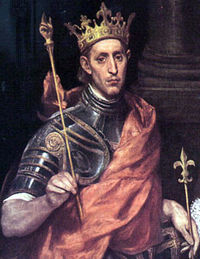Of San Fernando and San Luis Rey
Mission San Fernando Rey de Espana, the city of San Fernando and the valley of same are named after King Ferdinand III of Spain who was canonized by Pope Clement in 1671.
Ferdinand, a lay member of the Franciscans, permanently united Castile and Leon, partly through inheritance. He expanded Spanish control of the Southern Iberian Peninsula by capturing the Moorish strongholds of Cordoba and Seville.
 Ferdinand was born in 1199. His mother was Berenguela, the daughter of the king of Castile. Berenguela’s sister, Blanche, was the mother of Louis IX, the Crusader king of France.
Ferdinand was born in 1199. His mother was Berenguela, the daughter of the king of Castile. Berenguela’s sister, Blanche, was the mother of Louis IX, the Crusader king of France.
Louis built the stunning Sainte Chapelle in Paris to house what he believed was the true Crown of Thorns. Like his cousin Ferdinand, Louis was a lay Franciscan and eventually canonized – the only French king to become a saint.
Interestingly, the two missions that bear Ferdinand and Louis’ names – San Fernando and San Diego’s San Luis Rey de Francia – were the seventeenth and eighteenth missions respectively.
They were also the last two missions established by Father Fermin Francisco de Lasuen, who upon Father Junipero Serra’s death in 1785 became Father-President of the missions founding nine of them before his death in 1803.
Ferdinand was the eldest son of Alphonso, king of Leon. The pope dissolved Alphonso’s marriage with Berenguela because they were distant cousins. Berenguela and her children returned to the court of her father in Castile. Eventually, the throne fell to Berenguela but she gave the crown to 18-year-old Ferdinand.
He parried off an attack by his own father on Leon and then turned his attention to fighting the Moors.
Domestically, Ferdinand founded bishoprics, built and repaired churches and cathedrals as well as hospitals. He improved the University of Salamanca. He created a code of laws that was used into modern times.
In 1230, Ferdinand’s father died and so he also became king of Leon. He was the fist king of both Castile and Leon since 1157.
Ferdinand and his sword “Lobera” spent much of their time fighting Moors.
In 1236, he conquered Cordoba, which had been held by the Moors for 520 years.
It is said he fasted and prayed much, wore a hair shirt and would spend whole nights prior to battle in prayer. In the tumult of an army camp, he lived like a cleric. His army carried an image of the Virgin Mary. He had a small image of her on his breast.
For 16 months, Ferdinand laid siege to Seville, attempting to breech its double walls that were, in turn, protected by 166 towers. The Moors finally surrendered in 1248.
Ferdinand spent the last three years of his life in Seville. He was planning an attack on the Moors in Africa when he took ill and died at the age of 54.
He is buried in the Cathedral at Seville before the image of the Blessed Virgin wearing, per his request, a habit of the Third Order of St. Francis.
It’s said his body remains incorrupt and that many miracles have occurred at his tomb.
Fifteen years his cousin’s junior, Louis IX went on the 7th Crusade in 1248 – the year Ferdinand captured Seville. He lost his army in 1250 and was captured by the Egyptians. A ransom of nearly twice France’s annual revenue was paid to win his release.
In 1270 he joined the 8th Crusade where he died of dysentery in Tunis.
-30-
Filed under: California History
Capitol Cliches Conversational Currency Great Moments in Capitol History News Budget and Economy California History Demographics Fundraising Governor Legislature/Legislation Politics State Agencies
Opinionation Overheard Today's Latin Lesson
Restaurant Raconteur Spotlight Trip to Tokyo Venting Warren Buffett Welcome Words That Aren't Heard in Committee Enough

No comments yet.
RSS feed for comments on this post.